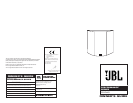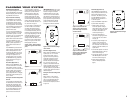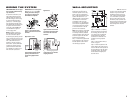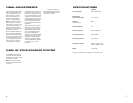
2 3
Unpacking the Speaker
If you suspect damage from transit,
report it immediately to your dealer.
Keep the shipping carton and pack-
ing materials for future use
.
Proper Placement and Setup
The P52OWS surround speaker
can be used in side or rear chan-
nel applications. Please refer to
the placement and setup method
for your application. The first step
is to determine the application for
which your P52OWS surround
speaker will be used.
If you are using the P52OWS for
surround channels in a 5-channel
home theater system or for side
channels in a 6- or 7-channel home
theater system (Application 1),
please follow the directions below.
To use the P52OWS as a rear
speaker in a 6- or 7-channel home
theater system (Application 2),
please follow the directions on
page 3.
The P52OWS also possesses the
unique capacity to behave as two
distinct loudspeakers from one
enclosure. This allows you to use
a single P52OWS for both the left
and right rear speakers in a 7-
channel system. If you are using
the P52OWS this way, please fol-
low the instructions on page 3
(Application 3).
Placement (Application 1)
When using the P52OWS for the
surround channels in a 5-channel
home theater system or for side
channels in a 6-or 7-channel home
theater system, refer to Figures 1
and 2. The speakers should be
placed perpendicular to or slightly
behind the primary listening loca-
tion, as shown.
Setting the Surround Configuration
Selector
It is generally recommended that
the selectable surround mode con-
figuration be set to Bipole. This
will provide a large ambient sur-
round sound field while allowing
for precise localization of sound
effects that the filmmaker has
placed in the surround tracks.
If the side walls on which the
speaker will be mounted are more
than about 14' (4.3m) from the
listening position, setting the
Surround Mode Configuration
Switch to Monopole may offer
improved performance. It is also
recommended that the Monopole
position be selected if the speak-
ers will be mounted close to a cor-
ner, as shown in Figure 2.
If you are using a receiver/proces-
sor with a THX
®
surround mode
and have selected the THX sur-
round mode, it may be beneficial
to use the Dipole setting. This is a
matter of personal preference and
may change depending on the indi-
vidual film soundtrack. It is also
recommended that the Dipole
setting be used with older record-
ings that are only recorded with a
Dolby
®
Pro Logic
®
(not the newer
Dolby Digital) soundtrack.
Figures1 and 2. These overhead
views show typical home theater
plans.
Figure 1.
Figure 2.
IMPORTANT NOTE: The set of driv-
ers closer to the monopole setting
indicator in Figure 3 should be
installed toward the front of the
room. It does not matter whether
the tweeter is positioned above or
below the woofer. This will ensure
proper operation and performance
should the Monopole or Dipole
position on the surround mode
configuration switch be selected.
Figure 3. Surround mode configu-
ration switch.
Placement (Application 2)
When using the P52OWS as a rear
speaker(s) in a 6- or 7-channel
home theater system, refer to
Figures 4 and 5. The speaker(s)
should be mounted on the rear
wall facing the listening area,
between the side channel speak-
ers. If you are using one rear
speaker, it should be mounted as
close as possible to the center of
the listening area. When using
two rear speakers, they should be
spaced evenly within the width of
the listening area.
Setting the Surround Configuration
Selector
When used as a rear channel
speaker in a 6- or 7-channel sys-
tem, it is recommended that the
Surround Mode Configuration
Switch be set to Bipole, as shown
in Figure 6.
(BIPOLE)
(DIPOLE)
(MONOPOLE)
Couch
Left
Front
Channel
Left
Surround
Channel
Right
Surround
Channel
Right
Front
Channel
Center
Channel
JBL
Subwoofer
(optional)
Couch
Left
Front
Channel
Left
Surround
Channel
Right
Surround
Channel
Right
Front
Channel
Center
Channel
JBL
Subwoofer
(optional)
PLANNING YOUR SYSTEM
Figure 4. This overhead view
shows a typical home theater
plan with a single rear-center
surround channel.
Figure 5. This overhead view
shows a typical home theater
plan when using two rear
channel speakers.
Placement (Application 3)
The P52OWS also possesses the
unique capacity to behave as two
distinct loudspeakers from one
enclosure. This allows you to use
a single P52OWS for both the
left and right rear speakers in a
7-channel system.
To use the P52OWS in Application
3, follow these simple steps:
1. Decide where you want to
mount the speaker. Ideally, it
should be mounted in the center
of the rear wall, similar to how
it would be mounted in a 6-
channel system (Fig. 4).
2. Loosen the terminals and
remove the strapping bars that
connect the two sets of termi-
nals (Fig. 9).
3. To ensure proper left/right con-
nections, make sure that the
speaker is in the “upright” posi-
tion. The label on the back of the
speaker should be readable, not
upside down.
4. Connect the speaker wire for the
RIGHT REAR speaker to the top
set of terminals (Fig. 10).
5. Connect the speaker wire for the
LEFT REAR speaker to the bot-
tom set of terminals (Fig. 10).
6. Set the mode configuration
switch to the Bipole position
(Fig. 6).
Figure 6. Surround mode configu-
ration switch.
(BIPOLE)
(DIPOLE)
(MONOPOLE)
Couch
Left
Front
Channel
Left
Side
Channel
Left Rear Channel
Right Rear Channel
Right
Side
Channel
Right
Front
Channel
Center
Channel
JBL
Subwoofer
(optional)
Couch
Left
Front
Channel
Left
Side
Channel
Right
Side
Channel
Rear Center Channel
Right
Front
Channel
Center
Channel
JBL
Subwoofer
(optional)






